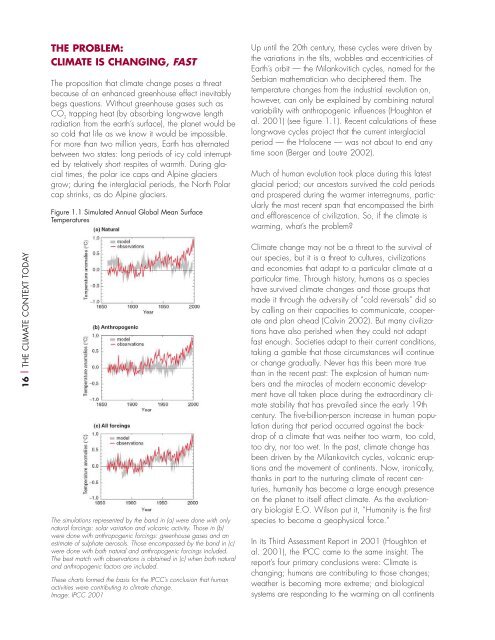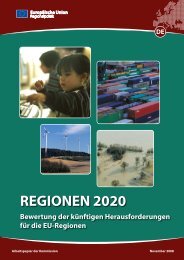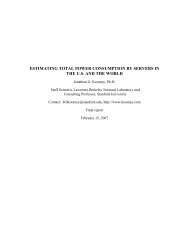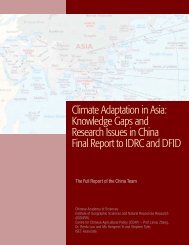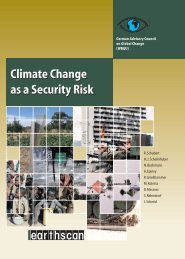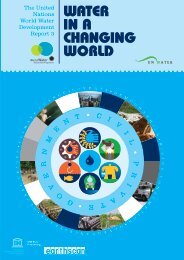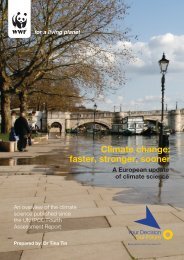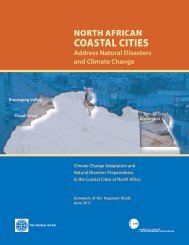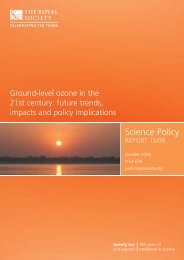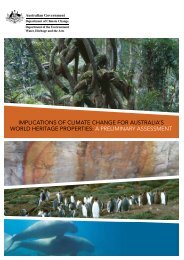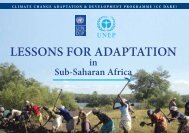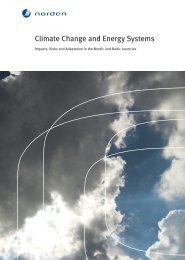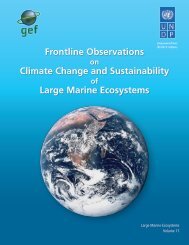Climate change futures: health, ecological and economic dimensions
Climate change futures: health, ecological and economic dimensions
Climate change futures: health, ecological and economic dimensions
Create successful ePaper yourself
Turn your PDF publications into a flip-book with our unique Google optimized e-Paper software.
THE PROBLEM:CLIMATE IS CHANGING, FASTThe proposition that climate <strong>change</strong> poses a threatbecause of an enhanced greenhouse effect inevitablybegs questions. Without greenhouse gases such asCO 2trapping heat (by absorbing long-wave lengthradiation from the earth’s surface), the planet would beso cold that life as we know it would be impossible.For more than two million years, Earth has alternatedbetween two states: long periods of icy cold interruptedby relatively short respites of warmth. During glacialtimes, the polar ice caps <strong>and</strong> Alpine glaciersgrow; during the interglacial periods, the North Polarcap shrinks, as do Alpine glaciers.Figure 1.1 Simulated Annual Global Mean SurfaceTemperaturesUp until the 20th century, these cycles were driven bythe variations in the tilts, wobbles <strong>and</strong> eccentricities ofEarth’s orbit — the Milankovitich cycles, named for theSerbian mathematician who deciphered them. Thetemperature <strong>change</strong>s from the industrial revolution on,however, can only be explained by combining naturalvariability with anthropogenic influences (Houghton etal. 2001) (see figure 1.1). Recent calculations of theselong-wave cycles project that the current interglacialperiod — the Holocene — was not about to end anytime soon (Berger <strong>and</strong> Loutre 2002).Much of human evolution took place during this latestglacial period; our ancestors survived the cold periods<strong>and</strong> prospered during the warmer interregnums, particularlythe most recent span that encompassed the birth<strong>and</strong> efflorescence of civilization. So, if the climate iswarming, what’s the problem?16 | THE CLIMATE CONTEXT TODAYThe simulations represented by the b<strong>and</strong> in (a) were done with onlynatural forcings: solar variation <strong>and</strong> volcanic activity. Those in (b)were done with anthropogenic forcings: greenhouse gases <strong>and</strong> anestimate of sulphate aerosols. Those encompassed by the b<strong>and</strong> in (c)were done with both natural <strong>and</strong> anthropogenic forcings included.The best match with observations is obtained in (c) when both natural<strong>and</strong> anthropogenic factors are included.These charts formed the basis for the IPCC’s conclusion that humanactivities were contributing to climate <strong>change</strong>.Image: IPCC 2001<strong>Climate</strong> <strong>change</strong> may not be a threat to the survival ofour species, but it is a threat to cultures, civilizations<strong>and</strong> economies that adapt to a particular climate at aparticular time. Through history, humans as a specieshave survived climate <strong>change</strong>s <strong>and</strong> those groups thatmade it through the adversity of “cold reversals” did soby calling on their capacities to communicate, cooperate<strong>and</strong> plan ahead (Calvin 2002). But many civilizationshave also perished when they could not adaptfast enough. Societies adapt to their current conditions,taking a gamble that those circumstances will continueor <strong>change</strong> gradually. Never has this been more truethan in the recent past: The explosion of human numbers<strong>and</strong> the miracles of modern <strong>economic</strong> developmenthave all taken place during the extraordinary climatestability that has prevailed since the early 19thcentury. The five-billion-person increase in human populationduring that period occurred against the backdropof a climate that was neither too warm, too cold,too dry, nor too wet. In the past, climate <strong>change</strong> hasbeen driven by the Milankovitch cycles, volcanic eruptions<strong>and</strong> the movement of continents. Now, ironically,thanks in part to the nurturing climate of recent centuries,humanity has become a large enough presenceon the planet to itself affect climate. As the evolutionarybiologist E.O. Wilson put it, “Humanity is the firstspecies to become a geophysical force.”In its Third Assessment Report in 2001 (Houghton etal. 2001), the IPCC came to the same insight. Thereport’s four primary conclusions were: <strong>Climate</strong> ischanging; humans are contributing to those <strong>change</strong>s;weather is becoming more extreme; <strong>and</strong> biologicalsystems are responding to the warming on all continents


